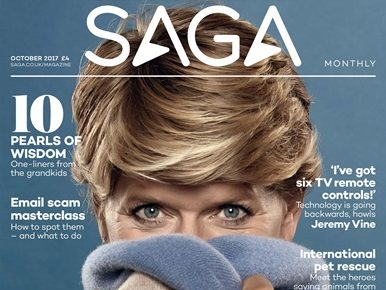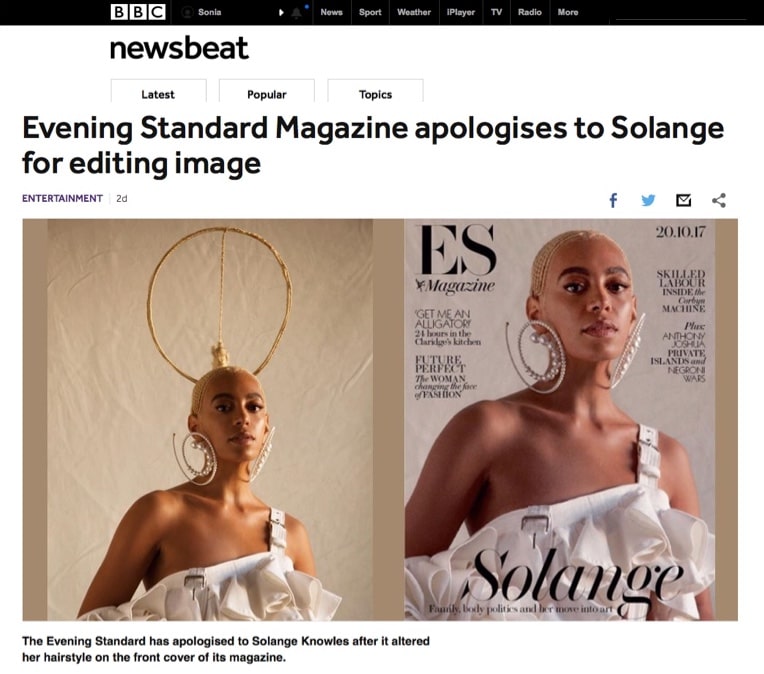Misrepresented in the media? Why it may not be the journalist’s fault
Being misrepresented in the media is very frustrating. During media training sessions, we often hear that people are reluctant to speak to the media because they have previously had “a bad experience”. “I was misquoted” or “the headline completely misrepresented the story” are two of the most common complaints.
And while the first reaction might be to blame the journalist, two recent controversies reveal that they aren’t always happy with the final version either – and sometimes it’s due to circumstances beyond their control.
Reporter’s fury over ‘distorted’ story
In the last week, The Evening Standard had to apologise to Solange Knowles for airbrushing a photo of her on the cover of its magazine. At the same time the journalist who had written the accompanying story angrily disowned the printed version in a series of tweets. Angelica Bastien revealed that she had asked for her name to be removed from the byline because she felt her work had been “distorted”.
Copy approval is controversial
And earlier this month, interviewer Ginny Dougray became involved in a row with Saga Magazine and Clare Balding over changes made to an article she had submitted. Ms Dougray was furious that the magazine seemed to have offered Clare Balding ‘copy approval’ and demanded that her name be removed from the article. Saga Magazine later clarified that its editorial team had made the changes themselves.

Saga clarified that its editorial team made changes to the article and stated that it did not give interviewees ‘copy approval’.
What these examples illustrate is that after the journalist finishes an interview, there is a more complicated process getting a report published or broadcast than many interviewees realise.
In most large news organisations, the journalist’s work is reviewed by a sub-editor, to check for typos and grammatical mistakes. They also make sure it is as short or long as needed (leading to another common complaint from interviewees; that they gave the journalist lots of information but very little of it appeared in the final version.) If an article is longer than needed, the sub-editor tends to just cut information from the end, without referring back to the original writer. However, they can if they choose completely rewrite it.
The article then goes to a headline writer. Their job is to come up with something which will grab a reader’s attention and interest them enough to read the rest of the story. It is designed to be eye-catching and, in one short sentence, cannot be a balanced representation of the whole story.
So if an article (and your contribution to it) doesn’t end up as you had hoped, it may not always be the journalist’s fault.
Avoid misrepresentation in the media, take control
From the interviewee’s point of view, there are some simple steps you can take to give yourself the best chance of your story being covered as you would hope.
- Be realistic: accept that being interviewed is taking part in an editorial process, it is NOT advertising. Mainstream news organisations rarely offer copy approval – even to the most famous. Asking for it just creates ill-feeling.
- Take control of your own contribution. Do your homework, and prepare content, messages and proof points which meet your objective while also meeting the needs of the journalist. You must be interesting and quotable.
- During the interview, use control techniques such as ‘bridging’ (and if you don’t know what that is, you should attend a Media Coach training course) to steer the conversation round to your agenda.
While the journalist may not have complete control of the whole process, the preparation will give the interviewee the best possible chance of winning interesting, accurate and favourable coverage: a win-win situation for all.
- Preparing for media interviews: don’t overlook the obvious question - February 4, 2020
- Interview soundbites: prepare in advance or journalists will feed you theirs! - October 11, 2019
- Why critics of media training miss the point - August 6, 2018






Oh Dear Oh Dear. It was all the sub’s fault. That much maligned breed is the butt of reporters’ and editors’ anger. They just can’t win! Speaking as a former sub-editor (Reveille, TitBits, Daily Telegraph Sports desk, Sun news subs) I can tell you that most of the time, the reporter’s copy, as filed, is illiterate drivel. Especially if it’s been filed against a really tight deadline (e.g. Wednesday night Premier League matches for Thursday morning papers) The story is buried, the quotes are too long-winded, the paragraphs are overblown etc., etc. It’s only in US journalism that the sub’s role is confined to fact, spelling and punctuation checks. In UK journalism, the sub will turn the story upside down, gut it, cut it and flip it, changing the emphasis entirely – and most of the time this is that the behest of the desk editor or chief sub. Good reporters, experienced ones, will phone their sub and work together on the polishing process. Good reporters know their sub can lift the prose into the poetic (and the story onto the front page or at least to page lead). But the war between subs and reporters is as old as newspapers, and will go on regardless of new media developments. It’s immature of a reporter to blame the sub for the way the story changed by the time it was published. The reporter clearly isn’t understanding the ethos of the publication, or the drivers behind subbing.
All the best
David